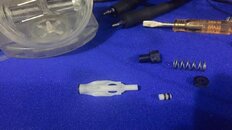DIR doesn't necessarily require unbalanced backup second stage regulators. Let's take a step back and explain the reasoning here. The actual requirement is that the backup reg can't lose gas when it gets hit by scooter prop wash or strong current (like when squeezing through a restriction in a high flow cave). When water flows past the mouthpiece then the induced pressure differential can exceed the cracking pressure. If your backup reg slowly free flows, then it's easy to lose a lot of gas without noticing. Back in the early days of DIR, unbalanced regs like the ScubaPro R190 were popular for that purpose because they were cheap and unlikely to free flow. But balanced second stages can be fine, too, as long as they can be tuned to not leak. Just test it out by sticking the reg with the mouthpiece pointing up directly behind a running scooter and see if any bubbles come out.
The notion of disassembling a reg underwater to clear debris is more of an advanced cave diving skill and not something that should be recommended to the majority of DIR divers. Cave divers squeezing through tight passages have their regs down in the muck where it's easy to pick up a rock or shell. And they may have a long way to go before switching to a stage. Whereas with ocean diving the problem is less likely to occur in the first place, and if it does then it's usually better to just abort the dive rather than risk losing pieces of your reg in a botched underwater repair. Taking the reg apart underwater can work and I've seen it done successfully but anyone considering doing this on a real dive should at least practice it in the pool a few times. Personally, I wouldn't try it.
Yes, I have used G260 as both a primary and backup. Works fine. You can turn back the adjustment knobs on the backup to reduce the risk of free flows.





